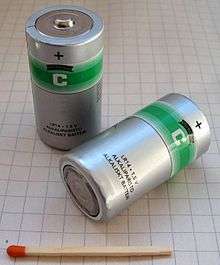C battery

The 'C' "battery" (or R14 battery) is a standard size of cell typically used in medium-drain applications such as toys and musical instruments.
As of 2007, C batteries accounted for 4% of alkaline primary battery sales in the United States. In Switzerland as of 2008, C batteries totalled 5.4% of primary battery sales and 3.4% of secondary battery sales.[1][2]
Properties

A 'C' battery measures 50 millimetres (1.97 in) length and 26.2 millimetres (1.03 in) diameter.[3]
The voltage and capacity of a 'C'-size battery depends on the battery chemistry and discharge conditions. The nominal voltage is 1.5V. Alkaline 'C' batteries can hold up to 8,000 mAh, rechargeable NiMH 'C' batteries can hold up to 6,000 mAh, and zinc-carbon 'C' batteries usually hold up to 3,800 mAh.
Standardisation
Like the D battery, the C battery size has been standardized since the 1920s.[4] The AA, AAA, and N sizes have been in common use since the 1950s.[5]
The C battery is called "14" in current ANSI standards of battery nomenclature, and in IEC standards is designated "R14".
Other common names
- U11 (In Britain until the 1980s)
- MN1400
- MX1400
- Baby
- Type 343 (Soviet Union/Russia)
- BA-42 (US Military Spec World War II–1980s)
- UM 2 (JIS)
- #2 (China)
- 6135-99-199-4779 (NSN)(carbon-zinc)
- 6135-99-117-3212 (NSN)(alkaline)
- HP-11
- Mezza torcia (Italy)
- Pila Mediana (Argentina)
- Pilha média (Brazil)
See also
References
- ↑ Life Cycle Impacts of Alkaline Batteries with a Focus on End-of-Life - EPBA-EU
- ↑ INOBAT 2008 statistics.
- ↑ IEC 60086-2 §7.1.3
- ↑ Ron Runkles (ed) A Brief History of the Standardization of Portable Cells and Batteries in the United States, American National Standards Institute Accredited Standards Committee C18 on Portable Cells and Batteries, 2002, ANSI Battery Standardization History, 2010 Jan 9
- ↑ Howard G. McEntee (March 1959). "Clever New Gadgets Run on Flashlight Batteries". Popular Science. Bonnier Corporation. 174 (3): 132. ISSN 0161-7370.
External links
- Brand Neutral Drawing Of Alkaline C Battery Based On ANSI Specifications
- Brand Neutral Drawing Of NiCd C Battery Based On ANSI Specifications
- Brand Neutral Drawing Of NiMH C Battery Based On ANSI Specifications
- Brand Neutral NiCd Batteries ANSI Specifications
- A datasheet for a C size battery: "Duracell MN1400 Datasheet" (PDF). Duracell. Archived from the original (PDF) on 8 June 2012. Retrieved 8 June 2012.
- Duracell Overview Of Primary Alkaline Manganese Dioxide Systems
- Energizer C Size Battery Specification for Alkaline Cell